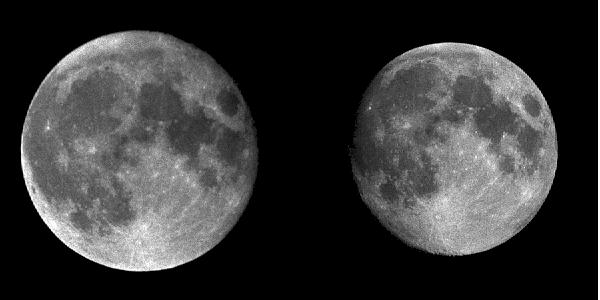 This is comparison of the Moon at perigee and apogee.
Because the lunar orbit has an eccentricity of 0.5490049
Cox-305, its distance
varies by about 11 % from perigee to apogee.
This means that the Moon's angular diameter decreases from
perigee to apogee by about 11 %.
The perigee-apogee comparison figure illustrates this point.
The difference is rather striking, but it isn't noticed
because humans have difficulty telling sizes without
a standard of comparison and, of course, we never see
perigee and apogee Moons together.
This is comparison of the Moon at perigee and apogee.
Because the lunar orbit has an eccentricity of 0.5490049
Cox-305, its distance
varies by about 11 % from perigee to apogee.
This means that the Moon's angular diameter decreases from
perigee to apogee by about 11 %.
The perigee-apogee comparison figure illustrates this point.
The difference is rather striking, but it isn't noticed
because humans have difficulty telling sizes without
a standard of comparison and, of course, we never see
perigee and apogee Moons together.
The one time we can notice the variation in lunar angular diameter is during TOTAL/ANNULAR SOLAR ECLIPSES: the Moon's angular size must be smaller during an annular eclipse than during a total eclipse. During total/annular solar eclipses, the Sun provides a standard of comparison.
There are some further complications to the changing angular diameter of the Moon that are well discussed in at the image credit site.
Credit: John Walker's Inconstant Moon page. John Walker has declared this page and its images public domain.